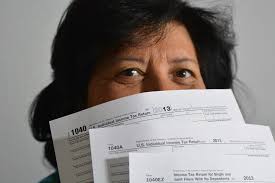 The Organization for Economic Cooperation and Development (OECD) recently released the 2016 income-tax rates for all 35 member countries. Rates were reported separately for two different categories: (1) single people with no children and (2) couples with one earner and two children.
The Organization for Economic Cooperation and Development (OECD) recently released the 2016 income-tax rates for all 35 member countries. Rates were reported separately for two different categories: (1) single people with no children and (2) couples with one earner and two children.
MarketWatch described the results under the headline, “Childless, single Americans pay more in income tax than single people in most countries.” That’s true. But when I looked closely at the report and did some of my own calculations, I found that another comparison was even more striking – and not in a good way.
First, let’s consider the findings described by MarketWatch, the income tax rates for single people with no children for all 35 countries. As you can see below, single people in the U.S. are taxed at a very high rate relative to many other countries. The 16.9% rate ranks 8th out of the 35 countries. Aside from four Nordic countries (Denmark, Iceland, Finland, and Norway), only Australia, Belgium, and New Zealand tax their single people at higher rates than the U.S. does. The very highest tax rate on single people with no children is nearly 36%, in Denmark.
Income tax rates (%) for singles with no children, 2016
35.9 Denmark
26.9 Iceland
23.0 Australia
20.8 Belgium
17.9 Finland
17.9 New Zealand
17.5 Norway
16.9 U.S.
16.4 Italy
16.2 Luxembourg
15.9 Germany
15.2 Netherlands
15.0 Latvia
13.8 Canada
13.8 Ireland
13.6 Sweden
13.4 Portugal
12.6 UK
12.5 Estonia
11.7 Hungary
11.6 Spain
10.8 France
10.8 Austria
10.4 Turkey
10.0 Switzerland
9.8 Slovenia
9.4 Czech Republic
9.4 Israel
8.5 Mexico
7.7 Greece
7.5 Slovak Republic
6.8 Japan
6.1 Poland
5.2 Korea
0.0 Chile
Now let’s look at the income tax rates for couples with one earner and two children. As you can see from the listing below, the U.S. is way down near the bottom. The 6% tax rate ranks 21st among the 35 countries.
You can also see that the very highest tax rate levied on the 1-earner couples with 2 children is lower (32%) than the highest rate on the single people with no children (35.9%). It is also worth noting that in two of the countries, the Slovak Republic and the Czech Republic, the relevant couples seem to have especially sweet deals: they get money back.
Income tax rates (%) for couples with 1 earner and 2 children
32.0 Denmark
23.0 Australia
20.0 Iceland
17.9 New Zealand
17.8 Finland
16.5 Norway
14.8 Netherlands
13.6 Sweden
12.1 UK
11.8 Belgium
11.2 Italy
9.5 Canada
9.4 Israel
9.1 Austria
8.7 Turkey
8.5 Mexico
8.2 Estonia
8.1 Greece
7.3 Latvia
6.1 Ireland
6.0 U.S.
5.9 Spain
5.8 France
5.8 Luxembourg
5.6 Japan
4.6 Hungary
4.0 Switzerland
3.4 Portugal
3.0 Korea
2.6 Slovenia
1.2 Poland
0.7 Germany
0 Chile
-1.1 Slovak Republic
-3.1 Czech Republic
DISPARITIES IN TAXATION
The big difference, in the U.S., between the income tax rate for the single people (16.9%) compared to the couples (6%) made me wonder about the relative disparities in all the other countries. The results, shown below, were remarkable. In only one country out of the 35, the Czech Republic, was the disparity in taxation even greater: singles there pay 12.5% more than the couples, compared to the 10.9% excess in the United States.
The consistency of the findings is also notable. Although a handful of countries tax the relevant singles and couples equally, only one country, Greece, taxes the couples more – and just by a smidge (-0.4%).
Extent to which single people with no children pay more in taxes than couples with 1 earner and 2 children (singles’ tax rate minus couples’ tax rate):
12.5 Czech Republic
10.9 U.S
10.4 Luxembourg
10.0 Portugal
9.0 Belgium
8.6 Slovak Republic
7.7 Latvia
7.7 Ireland
7.2 Slovenia
7.1 Hungary
6.9 Iceland
6.0 Switzerland
5.7 Spain
5.2 Italy
5.2 Germany
5.0 France
4.9 Poland
4.3 Canada
4.3 Estonia
3.9 Denmark
2.2 Korea
1.7 Austria
1.7 Turkey
1.2 Japan
1.0 Norway
.5 UK
.4 Netherlands
.1 Finland
0 Australia
0 New Zealand
0 Sweden
0 Israel
0 Mexico
0 Chile
-.4 Greece
The disparities in taxation do not tell the whole story, as I learned a few years ago when a scholar from Finland alerted me to a report on poverty levels in different kinds of households in 18 European countries. In every type of household except one, rates of poverty in Finland were quite low. They were 2nd lowest (of the 18 countries) for households with 2 adults and 3 or more children and also for single-parent households. The rate of poverty in Finland was 3rd lowest for households with 2 adults and 2 children, and 5th lowest for the couples with no children.
However, for one type of household – people living alone – the poverty rates in Finland were the second worst. Of the 18 countries, only Bulgaria had higher rates of poverty than Finland for its 1-person households.
By way of explanation, the Finnish scholar (who does not want to be named) suggests that pricing in Finland is based on the assumption that households have two incomes, leaving people living on their own especially vulnerable. In addition, there are not enough small, affordable apartments for single people, so their housing costs are disproportionately high, relative to their income.
The OECD report on taxation shows that single people in many countries around the globe are paying more than their fair share of taxes. The findings on poverty levels in Finland reminds us that even when disparities in income taxes are negligible, some single people may still be at risk, economically. Wouldn’t it be nice if we had powerful singles’ advocacy groups in every nation in the world, all working together for greater justice for people who are not married?
[Notes: (1) The opinions expressed here do not represent the official positions of Unmarried Equality. (2) The comment option on the UE website has been invaded by spammers, so I have disabled comments for now. I’ll post all these blog posts at the UE Facebook page; please join our discussions there. (3) For links to previous columns, click here.]
 About the Author: Bella DePaulo (PhD, Harvard), a long-time member of Unmarried Equality, is the author of Singled Out: How Singles Are Stereotyped, Stigmatized, and Ignored, and Still Live Happily Ever After and How We Live Now: Redefining Home and Family in the 21st Century, among other books. She writes the “Living Single” blog for Psychology Today and the “Single at Heart” blog for Psych Central. Visit her website at www.BellaDePaulo.com.
About the Author: Bella DePaulo (PhD, Harvard), a long-time member of Unmarried Equality, is the author of Singled Out: How Singles Are Stereotyped, Stigmatized, and Ignored, and Still Live Happily Ever After and How We Live Now: Redefining Home and Family in the 21st Century, among other books. She writes the “Living Single” blog for Psychology Today and the “Single at Heart” blog for Psych Central. Visit her website at www.BellaDePaulo.com.


